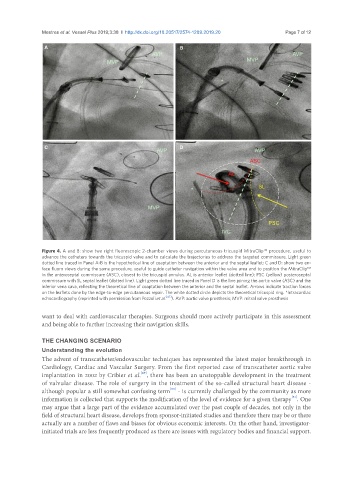Page 375 - Read Online
P. 375
Mestres et al. Vessel Plus 2019;3:38 I http://dx.doi.org/10.20517/2574-1209.2019.20 Page 7 of 12
A B
C D
Figure 4. A and B: show two right fluoroscopic 2-chamber views during percutaneous tricuspid MitraClip™ procedure, useful to
advance the catheters towards the tricuspid valve and to calculate the trajectories to address the targeted commissure. Light green
dotted line traced in Panel A-B is the hypothetical line of coaptation between the anterior and the septal leaflet; C and D: show two en-
face fluoro views during the same procedure, useful to guide catheter navigation within the valve area and to position the MitraClip™
in the anteroseptal commissure (ASC), closest to the tricuspid annulus. AL is anterior leaflet (dotted line); PSC (yellow) posteroseptal
commissure with SL septal leaflet (dotted line). Light green dotted line traced in Panel D is the line joining the aortic valve (ASC) and the
inferior vena cava, reflecting the theoretical line of coaptation between the anterior and the septal leaflet. Arrows indicate traction forces
on the leaflets done by the edge-to-edge percutaneous repair. The white dotted circle depicts the theoretical tricuspid ring. *Intracardiac
echocardiography (reprinted with permission from Pozzoli et al. [47] ). AVP: aortic valve prosthesis; MVP: mitral valve prosthesis
want to deal with cardiovascular therapies. Surgeons should more actively participate in this assessment
and being able to further increasing their navigation skills.
THE CHANGING SCENARIO
Understanding the evolution
The advent of transcatheter/endovascular techniques has represented the latest major breakthrough in
Cardiology, Cardiac and Vascular Surgery. From the first reported case of transcatheter aortic valve
[49]
implantation in 2002 by Cribier et al. , there has been an unstoppable development in the treatment
of valvular disease. The role of surgery in the treatment of the so-called structural heart disease -
[50]
although popular a still somewhat confusing term - is currently challenged by the community as more
[51]
information is collected that supports the modification of the level of evidence for a given therapy . One
may argue that a large part of the evidence accumulated over the past couple of decades, not only in the
field of structural heart disease, develops from sponsor-initiated studies and therefore there may be or there
actually are a number of flaws and biases for obvious economic interests. On the other hand, investigator-
initiated trials are less frequently produced as there are issues with regulatory bodies and financial support.

